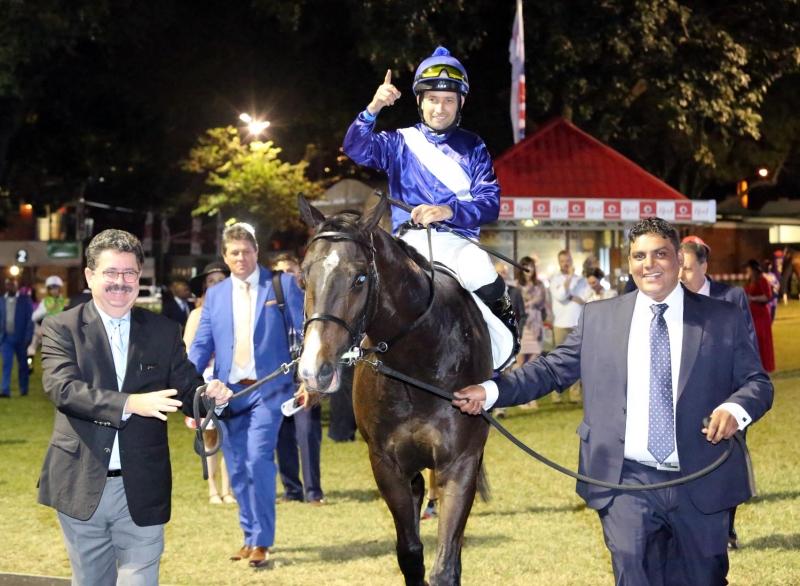“Dream big, anyone can buy a champion!”
So enthused leading SA trainer Glen Kotzen.
“You need good advice. A sound pedigree as in young stallions is always a great idea to come into the game. You want speed so you don’t need to wait too long to have a runner and a well related dam. She doesn’t need to have done much on the track but she must be well related in her pedigree – I love broodmare sires. It’s all about the dream!”
One of the most fascinating aspects of the thoroughbred world is its long and rich history, and the study of pedigrees – a horse’s father and mother are called his/her’s sire and dam respectively – is one of the sport’s most intriguing features.

Outstanding value for money buys include Al Mariachi who was trained by Brett Crawford, a R70 000 yearling buy for Mr. Glover, who earned nearly a Million after just 5 months on the track before departing to Mauritius.(Pic – Gold Circle)
Sarah Whitelaw writes that in basic terms, racehorses are either sprinters (fast horses who run from 1000-1200 metres), middle distance horses (horses who compete over distances ranging from 1400m to 2400m) or stayers (stayers, who contest races upwards of 2400m in trip, are often cheapest at the sales as they tend to take a longer time to mature and race).
Looking at a horse’s sire and dam is often a reasonable guide to determining his/her’s best trip – likewise, conformation often gives buyers a good idea of whether or not a horse is a potential sprinter or stayer.
However, while the study of pedigrees is fun and highly advisable before attending a sale, it should also be remembered that luck is also needed in buying a horse!
There have been many examples of horses outperforming their pedigrees, both in terms of quality and in terms of stamina, and no doubt many more will continue to do so.

The quality of a horse’s pedigree, i.e. if he is by a champion stallion out of a high-class race mare or broodmare, often dictates what price the horse fetches in the sales ring.
Well-bred yearlings often sell for upwards of R1 000 000, while horses sired by unfashionable or unproven stallions, in contrast, can be bought in the sales ring from R15 000 upwards.
While yearlings (thoroughbreds to race tend to sell when one-year-old) have made up to R9 000 000 in South Africa, sales price is not always a good guide to subsequent racing success.
One of the best racehorses, and thoroughbred stallions, bred in South Africa, Horse Of The Year and seven times champion sire, Jet Master, was a great example of a “cheap buy” making good.
Pat Devine fell in love with him and persuaded her husband Henry to buy him for just R15 000 as a weanling. Trained by Geoff Woodruff he went on to win 17 races and earn over R3 000 000 in prize money.
Jet Master was by no means the sole top horse who was cheaply sold, with other notable examples including Jet Master’s outstanding son J J The Jet Master (a R70 000 buy who became one of the world’s top sprinters) and R90 000 purchase The Apache. The latter subsequently finished first past the post in North America’s Gr1 Arlington Million before retiring to stud having earned one million pounds in earnings.
Another modern example is Sanshaawes bred by Oldlands Stud -a R30 000 buy from the 2011 Cape Yearling Sale who transferred from the Piet Steyn yard in Cape Town to earn over 2 000 000 Dhs while campaigning in Dubai with De Kock as his trainer.

Superfast Riverton Stud-bred Captain Of All (Pic – Gold Circle)
Riverton Stud are no strangers to producing top-class racehorses, who don’t cost an arm or a leg.
Perhaps the farm’s best example is the brilliant Captain Of All who was trained by Dennis Drier. A R100 000 yearling buy, he went on to be officially rated the World’s second fastest horse of 2015 while earning more than R2 200 000 in prize money.
Currently money-spinner Cirillo, trained by Sean Tarry for Chris Van Niekerk, a R300 000 purchase, has now earned over R5 Million.

Hugely talented big earner Cirillo (Pic – JC Photos)
South Africa has always had a tradition of genetic excellence.
Today that tradition still holds true with the driving force of captains of industry behind the likes of Drakenstein, Klawervlei, Maine Chance, Mauritzfontein, Ridgemont Highlands, Varsfontein, and Wilgerbosdrift Stud farms to name a few, continually investing to bring the bloodlines of top international stallions to our shores.
Kindly brought to you by Riverton Stud – click on the image below to find out more








